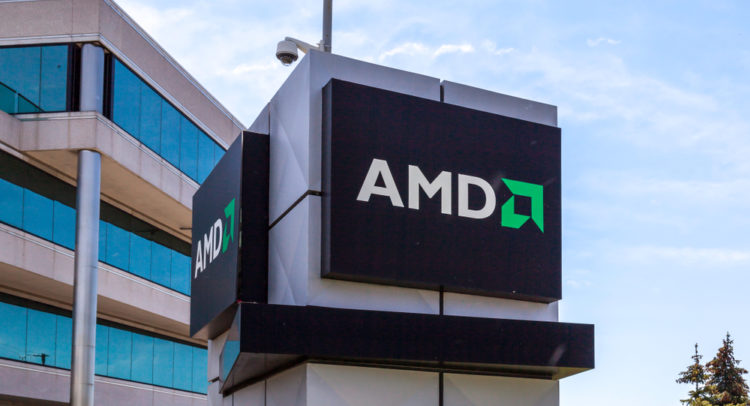For a company that’s known for explosive growth, 2021 has been a relatively disappointing year for semiconductor player Advanced Micro Devices (AMD). Considering the share price is up an astounding 2,198% over the last five years, it is disconcerting to have witnessed an 11%-plus drop since 2021 kicked off.
Elevate Your Investing Strategy:
- Take advantage of TipRanks Premium at 50% off! Unlock powerful investing tools, advanced data, and expert analyst insights to help you invest with confidence.
That raises the question, should investors buy the dip or head for the exits?
Fierce Competition In The Sector
Much of AMD’s recent progress has been at the expense of its competitor, Intel (INTC). At the same time, developments related to INTC account for some of the recent weakness in AMD. Intel recorded a small gain in the CPU market in the fourth quarter, and new CEO Pat Gelsinger is viewed by many as the right man to turn Intel around.
AMD is also facing renewed competition from NVIDIA (NVDA). In the middle of this month, NVIDIA introduced the Grace CPU chip. Designed specifically for use in data centers, NVIDIA claims Grace will deliver ten times the current performance on servers devoted to artificial intelligence (AI) and high-performance computing (HPC) tasks. Moreover, NVIDIA’S graphics processing units (GPUs) were adding market share even before Grace’s debut.
Robust Growth At AMD
Even so, AMD posted stellar quarterly numbers this week, and there are reasons to believe the firm will experience robust growth for the foreseeable future. The company reported a 93% increase in net revenue year-over-year.
Digging deeper, its Computing and Graphics segment revenue increased 46% year-over-year, and its Enterprise, Embedded and Semi-custom segment revenue grew 286% year-over-year. (See Advanced Micro Devices stock analysis on TipRanks)
Plus, at a time when many in the semiconductor industry were plagued with chip shortages, AMD reported a jump in inventory, with an increase from $1.4 billion in the previous quarter to $1.7 billion currently.
AMD also boasts a strong balance sheet, with cash, cash equivalents, and short term investments of $3.1 billion. Its long-term debt is at $313 million.
Wall Street Weighs In
Following the earnings call, Raymond Janes analyst Chris Caso initiated coverage of AMD with an Outperform rating and a price target of $100. Caso predicts AMD will retain an advantage in CPUs through at least 2024.
Shortly thereafter, additional analysts boosted their prices for the stock, with the average analyst price target of $106.14 implying 30% upside potential. According to TipRanks’ consensus breakdown, 9 analysts have recommended a Buy, 6 have rated it a Hold, and 1 rates it a Sell.

Upbeat Industry Projection
Perhaps of greatest importance, particularly for those concerned with the company’s growth trajectory, is management’s guidance for revenue growth of 50% in 2020. That represents an increase from prior guidance of approximately 37%.
One reason behind the upbeat projection is an expectation of growth in the data center, personal computer and video gaming markets.
According to a study by EMR, the latter is projected to grow at a CAGR of 9% from 2021 through 2026. Meanwhile, a study by MarketersMEDIA projects a CAGR of 4.8% for the data center server market from 2020 through 2025, and IDC forecasts 18.2% growth in the global PC market in 2021.
Xilinx Purchase A Boon To AMD
Late last year, AMD reached an agreement to buy Xilinx (XLNX). Expected to close late this year, the acquisition will increase overall sales by a third. The deal should also strengthen AMD’s presence in the data center chip market.
While AMD’s forward P/E ratio of 30.46 may cause some to pause, it stands as one of the lowest P/E multiples for the company since late 2017. As a matter of fact, during most of the last decade, the company’s P/E ratio has been at least two times that figure.
AMD’s PEG ratio of 1.41, which is well below the sector average of 2.08, indicates the shares are likely trading for a significant discount.
An evaluation of the stock presents a reasonable likelihood of continued growth for the foreseeable future. Furthermore, the acquisition of Xilinx, along with the firm’s strong financial foundation, supports the argument for investing in AMD.
Concluding Thoughts
For those who give credence to management’s growth projections, the recent sell-off in the shares represents an opportunity to grab a high growth stock at a relatively reasonable valuation.
Disclosure: On the date of publication, Chuck Walston had a position in AMD.
Disclaimer: The information contained herein is for informational purposes only. Nothing in this article should be taken as a solicitation to purchase or sell securities.
















